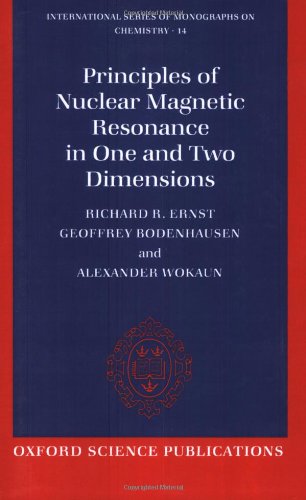Principles of nuclear magnetic resonance in one and two dimensions pdf
Par nance phil le samedi, juin 25 2016, 14:57 - Lien permanent
Principles of nuclear magnetic resonance in one and two dimensions. Alexander Wokaun, Geoffrey Bodenhausen, Richard R. Ernst

Principles.of.nuclear.magnetic.resonance.in.one.and.two.dimensions.pdf
ISBN: 0198556292,9780198556299 | 713 pages | 18 Mb

Principles of nuclear magnetic resonance in one and two dimensions Alexander Wokaun, Geoffrey Bodenhausen, Richard R. Ernst
Publisher: Clarendon Press
I learned most of my NMR knowledge by reading this book in The one I had read was first edition which was published in 1996. There is an increasing interest in materials holding antimicrobial properties because in several fields the use of these materials is mandatory, e.g. Protein NMR Spectroscopy: Principles and Practice. Filed under: book_list — kpwu @ 4:34 pm. Dimensions:9.25″H x 6.25″W x 1.75″D; 2.84 lbs. Nuclear Magnetic Resonance Imaging (NMRI), better known as Magnetic Resonance Imaging (MRI) in medical parlance, is an invaluable tool in the study of the neurological system, soft tissue and musculo-skeletal system disorders. Boron atoms have Through first-principle calculations of the interaction of boron atoms with various substrates, the team came up with several possible paths experimentalists may take toward 2D boron. Yet something like that keeps happening to experimentalists working to grow two-dimensional boron. Protein nmr spectroscopy Honestly, this book is really a “bible” for people doing NMR. Ronald M: Principles of microbiology. Crystallography and NMR: An Overview □ Aligned Membrane Proteins: Structural Studies □ Metabonomics: NMR Techniques □ Molecular Sieves: Crystalline Systems □ Relaxometry: Two-dimensional Methods. Yakobson feels the His team is one of two that have used NMR to detect hydrogen atoms in samples measuring just a few nanometres across. An even number of them will cancel each other's spin [just like two revolving spheres, in touch with each other would, in a 'classical world' (if one rotated clockwise, the other would rotate anticlockwise, canceling any resultant spin)]. The most common For instance, in 29Si NMR spectra of Au-C sample (Figure 2) four resonance lines at −96, −102, −108.3 and −113.6 ppm were identified, which correspond to Si(3Al), Si(2Al), Si(1Al) and Si(0Al) configurations, respectively [27].